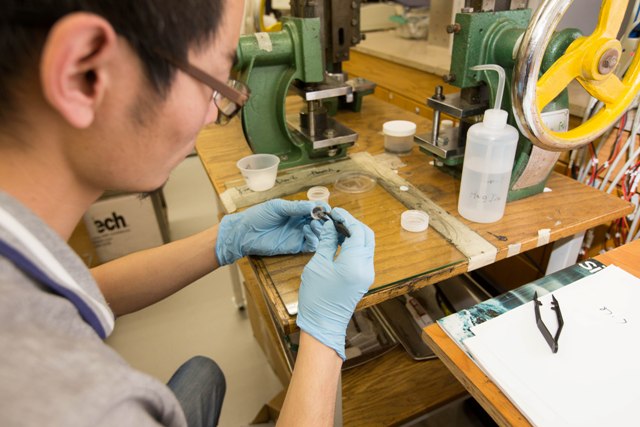Feb 2 2015
Researchers from the South Dakota State University (SDSU) have used a pyrolysis process to transform plant materials such as corn stover, native grasses and dried distillers grain solids (DDGS) into bio-oil and biochar, which could then be converted into graphene.
 Doctoral student KeLiang Wang places a graphene-coated electrode into a button cell to make a supercapacitor. Photo by Emily Weber
Doctoral student KeLiang Wang places a graphene-coated electrode into a button cell to make a supercapacitor. Photo by Emily Weber
The resulting product – graphene, is many times more valuable than the agricultural residue. Zhengrong Gu, an assistant professor at the SDSU agricultural and biosystems engineering department, states that the pyrolysis process converts the plant materials into biochar and bio-oil, and further processing of bio-oil transforms it into biofuel.
Biochar is a charcoal-like material, which Gu is converting into graphene. Activated carbon is a material that is used for coating the electrodes of supercapacitors, which are used for storage of energy. Activated carbon is expensive and graphene can be used in place of this material for electrode coating.
Gu explained that start-up and run capacitors are used by small engines, however supercapacitors possess a higher energy storage capacity and also have more fast charge and discharge rates. Supercapacitors also have the ability to can withstand low temperatures, which conventional batteries cannot.
The United States imports most of its activated carbon requirements from Asian countries including Japan, China and Thailand, for manufacturing supercapacitors. “We can use these abundant agricultural materials as biofuel to reduce our dependence on petroleum and, at the same time, generate good active carbon to export,” Gu said.
Gu estimates that around 2.2lb of graphene has a value of $1,000. The cost of 1lb of DDGS is around 7.5-9¢, which when converted produces approximately 7oz of graphene.
“That’s the increased value of the product,” Gu said. “We can convert agricultural residue to a high-value product that is easy to ship.”
After transformation of the corn stover or DDGS into biochar, a catalyst is mixed with the biochar, and this mixture is heated to 1,292°F for duration of one hour. The resultant product is porous graphene.
“It’s a one-step process,” he said. Gu estimates that including feedstock, it would cost about $1.36 to produce 1lb of graphene.
Using the native grass big blue stem as the feedstock, Gu said, “we save more on feedstock.”
SDSU had developed a new plasma processing technique, and Gu hopes to adapt this technique for converting biochar to graphene, which would reduce the required processing temperature to 302°F and the time required for processing to five minutes. This would help achieve significant savings in cost, Gu added.
The process developed by Gu produces graphene with the properties required for capturing and discharging electricity, however, Gu disclosed that, “We don’t know how the reaction happens.”
The National Science Foundation has awarded a grant of $775,155 and SDSU has granted matching funds of $332,210. A team of SDSU researchers and Gu, who are conducting research on biofuel technologies and carbon materials, have used these funds to acquire a transmission electron microscope which would reach the university in spring.
“We can find out how the process happens and learn how to change the parameters to improve the end product,” Gu said.
Gu and his research team would be able to find out the internal material structure and the way the morphology modifies its energy storage properties, using the transmission electron microscope. This would be similar to doctors utilizing a CT scan for examining the human body. The microscope would also help them the rate the quality of graphene obtained from different kinds of biochars.